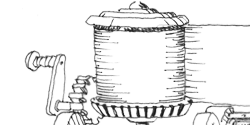BUY IT on Amazon.com
or
If you're in Berkeley, check for it at these local bookstores that we recommend:
Builder's Booksource
Moe's
SUMMARY
"If the world is to make great gardens again, we must both discover and apply in the changed circumstances of modern life the principals which guided the garden-makers of the Renaissance, and must be ready to learn all that science can teach us concerning the laws of artistic presentment."
--Sir George R. Sitwell 1909
The ideas for this book were formed in the early 1970s when the oil crisis alerted the world to its dependence on diminishing fossil fuel reserves. The typical architectural and engineering solutions to the "energy crisis" was to make building more efficient for mechanized heating and cooling. Garden and Climate is an important and needed book on energy conserving landscape and architectural design. This book investigates historical approaches to passive microclimatic design and presents a broad array of examples of implementing the wealth of past knowledge into modern environmental design.
The spark for Garden and Climate ignited during 1984-85 when I was a fellow at the American Academy in Rome. I traveled in Italy throughout the year and was astonished at the gardens I visited. Here were magnificent works of art, which were also incredibly practical and effective at moderating the extremes of local climate. Inspired by this synthesis, I began searching for books that addressed both aesthetics and passive microclimate design. I could find none. The few books on energy-efficient design that are available tend to ignore the subject's long history and discuss climate only as a physical influence. I set out to write a book that hopefully provides a more complete understanding of past and present human relationships to the environment.
Garden and Climate describes historical trends and examples as inspiration for modern landscape designs. It addresses the emotional as well as the physical influences of microclimates. Its overarching goal is to inspire design, which balances beauty with responsibility. Additionally, this book seeks to build upon and refocus some earlier works such as Design with Climate, Plants, People and Environmental Quality and Landscape Planning for Energy Conservation.
Now more than ever we need to create landscapes that help conserve energy, in the United States we are presently relying on imported oil more that ever. Oil imports now, account for a record fifty percent of consumption, up from thirty five percent in 1973. Energy-efficient garden planning is still in its infancy. Many new and exciting possibilities lie ahead in the creation of new garden forms for energy conservation. Innovative passive design solutions that are proposed in Garden and Climate could help reduce our growing energy demands not only in the landscape of America, but most importantly, throughout the world.
Since its publication, Garden and Climate has been reviewed extensively and was recognized by the New York Times as a notable book. It was also the recipient of a Merit Award by the American Society of Landscape Architects.
TABLE OF CONTENTS
Foreword
Introduction
Acknowledgments
BOOK I: EARTH
Postulate I: Earth Seats
Postulate II: Grottoes
Postulate III: Subterranean Rooms
Postulate IV: Cyrptoportici
Postulate V: Boscoes
Postulate VI: Pineta
Garden Prototype I: The Garden of Bacchus
BOOK II: FIRE
Postulate I: Hot Seats
Postulate II: Warm Walks
Postulate III: Sunlit Terraces
Postulate IV: Warm Loggias
Postulate V: Courtyards
Postulate VI: Giardini Segreti (Secret Gardens)
Postulate VII: Liminaias (Warm Rooms)
Garden Prototype II: The Garden of the Phoenix
Notes
BOOK III: AIR
Postulate I: Cool Seats
Postulate II: Cool Walks
Postulate III: Shaddy Tunnels and Pruned Walks
Postulate IV: Arbors and Pergolas
Postulate V: Garden Pavilions and Summerhouses
Postulate VI: Interior Porches and Cool Rooms
Garden Prototype III: The Garden of Juno
BOOK IV: WATER
Postulate I: Water Catchment Devices and Irrigation Methods
Postulate II: Placid Water Devices
Postulate III: Active Water Devices
Postulate IV: Aerated Water Devices
Postulate V: Wet Walks
Postulate VI: Water jokes
The Garden of Neptune
Notes
Conclusion
Bibliography
Index








